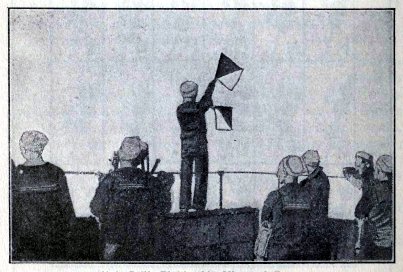76 GILBERT BOY
ENGINEERING
The short piece of moulding is
lettered with capitals starting with A at top, going down or
the reverse of the lettering on the longer piece, which starts
at bottom going up.
The number 10 on the small piece and the opposite number on
the long piece are used as keys to cipher.
Method of Using Cipher
Outfit. By referring to Figure 22 it will be seen at
once that to change the cipher all that is necessary is to
shift the small piece of picture moulding up or down. Each
sending and receiving station would have this outfit handy,
and to send a message the following procedure should be kept
in mind.
Encipher or, that is, put your message into cipher from
capitals to the opposite small alphabet.
To decipher a message at receiving station use the reverse
method.
To give the receiver the proper key to cipher; this can be
done by signaling the key in the preamble of your message; for
example, the message : "WE
BREAK CAMP AT SUNRISE" would be sent, if taken from
Figure 22, as follows: (Key) 1027
QI
LVIMC KMAX MT USZVEUI.
77 GILBERT SIGNAL
ENGINEERING
Chapter VIII
MARITIME SIGNALING
United States Maritime
Signaling is divided into two branches: that of the Merchant
Marine and that of the Navy. The signal methods of the
Merchant Marine apply in all cases to privately owned yachts,
power boats and other small craft having use for a signal
system.
To be well versed in Maritime Signaling it is necessary for a
signalist to know wherein the methods differ between U. S.
merchant vessels and ships of the U. S. Navy.
U. S. Merchant Marine
Signaling. The methods of signaling in the U. S.
Merchant Marine are based entirely on the International Code
of signals, which is the result of many years of work on the
part of the International Marine Conference.
The International Signal Book is used by all vessels
throughout the world, both merchant and men-of-war, thus
enabling all ships to carry on communications by signals, even
without the knowledge of one another's language.
Every signal in the International Signal Book has the same
meaning in any language.
Signals are sent from the International Signal Code by means
of the following systems :
Flag Hoists,
International Morse Code, which is same as General Service
Code, International Flag Waving, Colombs Sound and Flashing
System and International Distance Signals.
The most general method of signaling by vessels is by means of
flag hoists in which the International Code flags are
employed.
78 GILBERT BOY ENGINEERING
There is nothing that gives a
poorer impression to expert signalmen, or those who know, than
to observe the misuse of flags in signaling. For this reason
the writer will acquaint you in a general way with a few
nautical terms relating to flag hoist signals and correct form
of handling flags.
FLAGS AND CORRECT WAY OF USING
The Hoist of any flag is the side fastened to
flagstaff or line holding it.
The Fly of a flag is
at right angles to the hoist. (See Figure 23.)
A Hoist of flags is
a number of signal flags on one line or hoist.
The lines by which a signal flag or flags are hoisted are
called halyards.
That part of halyard which is attached to upper hoist of flag
running through pulley or block is termed the down haul.
That part of halyard which is connected to the lower hoist of
the flag or flags is termed the tail. (See Figure 23.)
Flag signals on merchant ships are usually hoisted to the most
convenient position on the yardarm or mast from which signals
can best be seen and distinguished. However, on most of
the larger ships a special signal
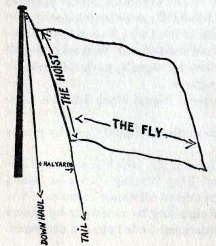 FIG. 23
FIG. 23
79
GILBERT SIGNAL ENGINEERING
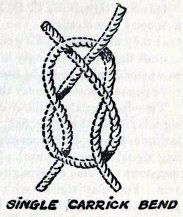 FIG. 24
FIG. 24
yard is used on the foremast
which is situated ahead of the ship's funnels. The signals are
not then obscured by smoke except in a case where receiving
ship is dead astern.
Signal flags are flown from either Port (left side of a ship) signal yardarm, or
Starboard (right side
of a ship) signal yardarm according to position of the
receiving ship.
A flag is said to be close up when hoisted to its limit on a
yardarm or mast and at dip when only hoisted two-thirds of the
way up. (See Figure 25.)
The Peak of a mast is
extreme top point. All signal and special distinguishing flags
vary in size and shape; however, in regard to shapes, a way of
classifying as to proper names can be found by consulting
Figure 27.
Signal flags are fastened on the halyards by means of a ring
at the upper end of the hoist of flag and a snap hook at lower
end. They may be tied to halyards by means of a single carrick
bend. (See Figure 24.) The last method is clumsy and slow. All
of the up-to-date merchant lines and navies that have a great
many signals to handle use rings and hooks.
FLAGS OF THE INTERNATIONAL CODE AND HOW USED
The International Code flags
are twenty-six in number one for each letter of the alphabet
and also a code pennant, all of which are pictured on Chart
10. (See special section of colored flags.)
80 GILBERT BOY ENGINEERING
One-flag signals B, C, D, L, P, Q and S hoisted singly have a
special significance. The code pennant over each indicates
that they are signals of a general nature and of frequent use.
Code flags hoisted singly after numerals signal Number 1 refer
to numeral table in Code Book, as do also two-flag signals
with code pennant hoisted under them.
Two-flag signals without code flag are urgent and important
signals; with the code flag hoisted over them they are time,
latitude, longitude, barometer and thermometer signals.
Three-flag signals express points of the compass, money,
weights and measures and also other signals required for
general communication. Four-flag signals with a burgee (A or B) uppermost
are geographical signals; with C uppermost they are spelling
or vocabulary signals; with G uppermost they are names of men-
YARD
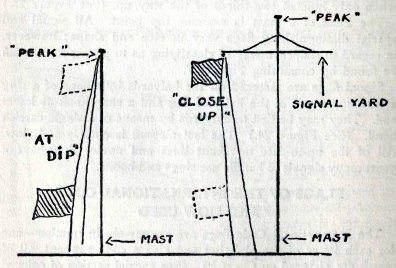 FIG. 25
FIG. 25
81
GILBERT SIGNAL ENGINEERING
of-war; with a square flag
uppermost they are names of merchant vessels.
The following are meanings given single flags already
mentioned :
B. Am taking on (or unloading) explosives.
C. Yes or affirmative.
D. No or negative.
L. I have (or have had) infectious disease aboard.
P. I am about to sail ; all persons report on board.
Q. Have clean bill of health, but liable to quarantine.
S. I want a pilot.
Single flags are sometimes used as signals from a towing ship
to ships in tow; the meanings when used thus do not, however,
correspond in any way to above signals.
METHOD OF SIGNALING WHEN NO OTHER SHIPS ARE IN SIGHT
Example : Ship A wants to signal ship B. Ship A will hoist her ensign
(national colors) over the code pennant but not on the same
halyard. If hoisted at same mast as succeeding signal the
methods will interfere. As soon as ship B makes out the attention
signal she will answer by hoisting the code pennant at dip;
then ship A proceeds
with signals, first hauling down the code flag, and when
completed ship B
acknowledges by hoisting the code pennant close up and leaves
it there until ship A hauls down the hoist of signals after
which she lowers it to dip, and awaits the next signal.
When ship A has completed her signals she hauls down the
ensign and the other ship hauls down the answering pennant
(code pennant).
82 GILBERT BOY ENGINEERING
All flag hoists are read from
top down and never exceed four to the hoist.
In case several ships are in sight and ship A wishes to signal ship B,
she will attract attention of B by either of two ways; the
first, is to hoist B
ship's distinguishing letters or, second, to hoist the
two-letter signals which indicate direction the ship she
wishes to call is traveling.
All vessels are supposed to display their distinguishing call
letters when passing at sea.
DISTANT SIGNALS
When in consequence of
distance, wind or weather preventing the code flags from being
seen, an alternative method of signaling is used, which is
known as distant signals.
There are three ways of making distant signals:
1. By means of the Fixed Coast Semaphore.
2. By means of square flags, pennants and whefts.
3. By means of cones, balls and drums.
Calm weather and when wind is blowing from and towards the
receiving station are the reasons that make it difficult to
make out the colored flags of the International Code. For this
same reason the method of distant signaling by means of square
flags, pennants and whefts is not as preferable as by the
cones,
balls and drums. A wheft is any flag tied in center to
halyards; therefore this system is mostly used.
Chart 15 gives the distant signal alphabet by balls, cones and
drums.
The shapes are made by stretching canvas over pieces of light
wood or metal forms, the canvas is as a rule then painted
black.
The signals are made from International Signal Book and hoists
are read from top down same as the flags.
83 GILBERT SIGNAL ENGINEERING
DISTANT SIGNAL ALPHABET
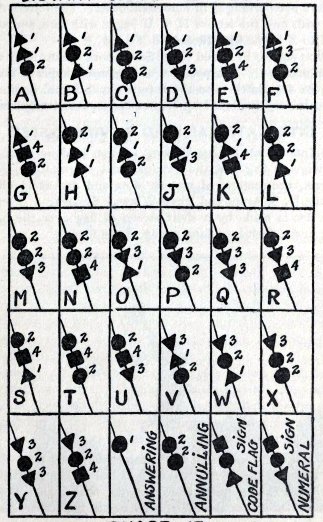 CHART 15
CHART 15
84
GILBERT BOY ENGINEERING
For convenience in their use
the shapes representing the letters have been arranged in
numerical order. The letters A to G begin with one, the
letters H to U begin with two, and the letters V to Z begin
with three.
Distant signals by Fixed Coast Semaphore are made by a
semaphore machine. The position of the arms indicate numbers
which are translated from the International Signal Book. This
method is only employed by shore stations and not by ships.
INTERNATIONAL FLAG WAVING SYSTEM
The International Flag Waving
System is done by a single stick wigwag flag and the
International Morse Code is used. However, the method of
making dots and dashes is different from the U. S. Army and
Navy Wigwag System.
The dot is made by a short sweep of flag over the head of
sender and a dash by a long swing of the flag.
85
GILBERT SIGNAL ENGINEERING
Chapter IX
U. S. NAVY FLAG SIGNALS
The flag signal system of the
Navy is in all probability the most important of all day
signal methods. It has the advantage over the two-arm
semaphore, either hand flags or machine method, and the wigwag
which are the other day systems used by the Navy and which
have already been explained.
The advantage of flag signals in the Navy is the great range
and its adaptability to fleet manoeuvering and battle tactics.
The flag signals are made by hoists transmitting the Navy Flag
Code, this flag code can also be sent by all the other signal
methods used in the Navy.
When flags are necessary for intercommunication between the U.
S. Army and all merchant ships, the International Flag Code is
used.
The term "break" or flag is "broken" will come up in
connection with Navy flag signaling, so it will be well to
acquaint you with the proper way of making up a signal flag
for breaking.
There are several ways to do this, but the following plan, if
followed, will prove the most reliable :
Figure 26 (A) shows a signal flag lying flat on the deck ready
to be made up for the "break." To do this the flag is folded
on dotted lines 1 and 2 and then rolled towards the hoist as
in B, after which the tail line is laid on top of rolled flag
in form of a loop. The free end of line is then wrapped
securely around the roll and over the loop by a number of
turns and again looped into the end of other goose neck (see
C) and drawn tight, which serves to clinch the tail line.
86 GILBERT BOY ENGINEERING
The flag is then ready to
hoist as in D, after which it can be broken by simply giving a
sharp tug on the tail line.
The foremast is principally used for signaling by naval ships,
except in the case of a flagship which flies her signals from
the
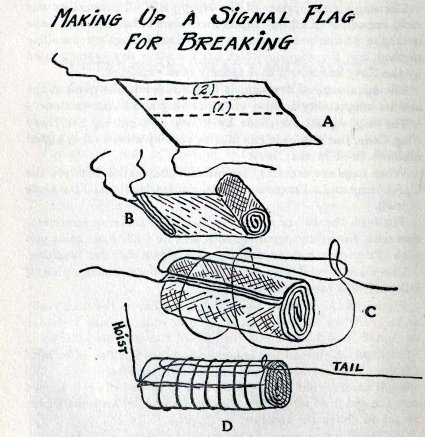 FIG. 26
FIG. 26
87
GILBERT SIGNAL ENGINEERING
main mast. The signal yards in
either case are usually provided with three to six signal
halyards on each port and starboard side. The peak of a mast
on a naval ship is usually termed the truck.
HOW NAVY SIGNALS ARE EXECUTED
The General Signal Book of the
U. S. Navy contains a list of signals known as the Navy Flag
Code. This book is divided into various parts, some of which
are very confidential and are in the hands of only the higher
officers.
The method of making the signals is alike no matter from what
section or volume, as the meanings are arranged in
alphabetical order opposite the signals to be sent.
The flags and pennants used in the Navy for making flag
signals are the alphabet flags of the International Code
flags, except the code pennant (see Chart 10) and a number of
special flags and pennants contained in Charts 11 and 12.
While the alphabet flags of the Navy Code are same in design
as those of the International Code, they have no connection
whatever. A distinct naval feature is to call the flags by
name rather than by letter, the name applied to the alphabet
flags are able for A,
boy for B, etc., same
as the conventional signals used for telephoning on page 66.
CALLS
Each ship in the Navy is
furnished with a call, which is a combination of two letters
like ZL, PN, or AD.
For sake of convenience the first letter of a ship's call
represents the group to which that ship belongs and the second
letter the ship of that particular group.
One set of flags is used for the group and another for the
ship.
88 GILBERT BOY ENGINEERING
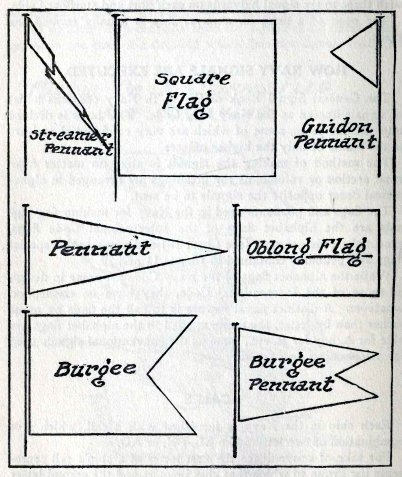 FIG. 27
FIG. 27
89
GILBERT SIGNAL ENGINEERING
The two-letter call of each
ship is made by using one of the call flags and one of the call pennants. (See Chart
11.)
In order to furnish calls to squadrons, divisions, etc., of a
fleet additional flags are used for indicator flags and will
be found on Chart 12 under the title, Squadron, Division,
Torpedo Flotilla and Submarine Flotilla.
The call of a particular ship wanted to take a message would
be made (in case of a number of naval ships of various classes
in immediate vicinity) by its indicator flag with call letters
hoisted underneath.
Where a general call or message is to be given to all ships
within signal distance, the cornet flag is hoisted without
individual call letters and all ships are required to answer.
All naval vessels passing at sea always hoist their call
letters. The answering pennant is used to answer all flag
signals, and is hoisted from point best seen (at truck or
either side of the signal yard) and is kept there until ship
signaling hauls down the signal. The answering pennant is also
used as a divisional point in making a numeral hoist.
The alphabet flags from Q
to Z are designated
as numerals from 1 to respectively and are so indicated when
the numeral flag precedes them on a hoist.
The repeaters 1st, 2d and 3d serve to reproduce numeral
hoisted above them. The first repeater would act as a repeater
for the first flag, 2d repeater for second and so on. For
example, the numeral 232 would be hoisted using the numeral
flag followed by R(2), S(3) and first repeater.
The numeral 2222 would be hoisted R(2) 1st, 2d, and. 3d
repeaters.
The Preparatory Flag (L) means prepare to execute signal
shown. It is also used as a time signal by the flagship or
senior ship present, in which case it is hoisted at 6:55 A. M.
and hauled down promptly at 7 A. M. It also indicates that the
90 GILBERT BOY ENGINEERING
uniform of crew is same as
yesterday. When hoisted at 7 : 45 A. M. over a numeral it
indicates the size of the ensign (colors) ships are to hoist
at 8 A.M. It is hauled down at 8 A. M. and all ships then
hoist the national colors.
The Interrogatory Flag (O) hoisted over a signal changes its
meaning into the interrogatory form.
The Affirmative Flag (P) when hoisted in answer to a signal
means yes, or permission granted.
The Negative Flag (K) when hoisted in answer to a signal means
no, or request not granted.
The Annulling Flag (N) annuls all signals at time display on
the same mast, hoisted alone it annuls a previous signal which
has just been made.
The Quarantine Flag (Q) hoisted at foremast truck indicates
ship is under quarantine or has an infectious disease aboard.
The Guard and Guide Flag, when hoisted at fore truck in port
between sunrise and sunset, indicates that that ship is
charged with the guard duty for that day (a red truck light is
used at night at foremast).
When hoisted by a ship under way it indicates that that ship
is to guide the formation.
The guard flag is displayed on all the small boats belonging
to the ship doing guard duty. The guard flag, however, is not
displayed in any way by a flagship if they are performing that
duty.
The Convoy and Position Pennant is worn at the foretruck of
all ships on convoy duty; in formation, when hoisted at dip it
signifies "I am temporarily out of position.'
The Danger and Designating Flag hoisted alone means danger
ahead; a compass signal under it signifies the direction from
which danger is expected.
The Dispatch and Breakdown Flag (I) when worn at main truck
indicates that that ship is on dispatch duty; in fleet
formation this flag is always kept rounded up ready to "break"
at
91 GILBERT SIGNAL
ENGINEERING
foretruck and when "broke," it
signifies a breakdown of ships machinery or the steering gear.
In case of a man overboard it is "broken" and lowered at dip.
The General and Boat Recall Flag. Hoisted alone this flag
calls all the small boats back to their respective ship at
once. When hoisted under a number it recalls only that boat or
boats having these numbers. At night small boats are recalled
by the display of I followed by boat numbers and the call
letters of ship signaling.
The Powder and Firing Flag (B) is displayed at the foremast of
all naval vessels engaged in taking on board explosives, such
as loaded shells, fuel oil or gasoline.
The Meal, Full Speed and Flag Officer Leaving Pennant, when
hoisted singly at the port yardarm by a ship at anchor,
signifies that crew is at meal ; if hoisted at sea on same
yardarm with the speed cone, it means one knot faster than
standard speed; alone with speed cone it denotes full speed;
and when hoisted under the flag of any flag officer it conveys
the fact that that officer is leaving the ship.
The Battle Efficiency Pennant is shown at the foremast (when
ship is at anchor) of ship or ships which are authorized to
fly same. The Battle Efficiency Pennant is awarded each year
by the Navy to one ship in each of the battleship, submarine
and torpedo boat class for excelling in gunnery and
engineering for that particular year.
The Church Pennant is hoisted over the ensign while divine
services are being held, it is the only flag ever hoisted over
the ensign for any reason whatsoever.
The Red Cross Flag is an International flag flown by all
hospital ships, their small boats and also flown at Naval
Field Hospitals. The flag is flown at the bowstaff on ships.
The Submarine Warning Flag is hoisted and flown by any vessel
or small boat acting as a mother ship or fender to sub-
92 GILBERT BOY ENGINEERING
marines, and it signifies that submarines are submerged or
operating in that vicinity.
U. S. NAVAL FLAG ETIQUETTE
Every ship in the U. S. Navy
carries a complete set of the various national ensigns of
other countries. Some nations have two ensigns, each different
in design, one for men-of-war and another for merchant
vessels. In the case of the United States government the
national colors are alike for both naval and merchant ships.
The national ensigns of foreign countries are flown from the
main mast of U. S. Naval vessels on occasions such as a visit
from the head of a foreign government or any other high
officials, either diplomatic, military or naval. In American
or foreign waters, on occasion of such a visit, the national
ensign of the country the official represents is made up and
"broke" at main mast as the visitor or visitors step aboard.
At time flag is broken the saluting battery fires the proper
salute that the visitor is entitled to.
U. S. Naval ships upon entering a foreign port always "break"
the national ensign of the nation visited and fire a salute of
twenty-one guns. The salute is answered by the highest
official present from either a naval vessel or a military
shore station or fort.
U. S. Naval ships passing other men-of-war or merchant ships
at sea always dip the colors in answer to the same courtesies.
It is customary for merchant ships of either U. S. or foreign
countries to dip colors to the men-of-war first. However, in
case of naval vessels meeting, the junior officer always dips
first to his senior. No salutes are fired as a rule to naval
officers of a rank lower than a flag officer, which in the U.
S. Navy is a Rear Admiral or above in rank, except where an
officer lower in rank may be acting in that capacity.
93 GILBERT SIGNAL
ENGINEERING
TIME FOR FLYING COLORS
The time for flying of the
national ensign on naval ships is given by the senior officer
present. The size of colors to be used is also designated by
signal. As a general rule the colors are hoisted at 8 A.M. in
port and at the flagstaff at stern of ship with the proper
ceremonies. At sea the colors are hoisted at the gaff (small
spar projecting from the main mast). The colors are lowered at
sunset with the same ceremonies, but at sea the colors are
usually replaced after being lowered by a smaller ensign which
flies all night, as do certain other special designator and
personal flags. It is not customary to signal by means of
flags before morning or after evening colors.
The Union Jack is hoisted in port only and at jackstaff in
bow. It is hoisted at morning colors and lowered at evening
colors. The Union Jack hoisted at fore signal yard indicates
there is a general court martial or court of inquiry being
held aboard. When hoisted for such purposes a gun is fired.
The Union Jack hoisted at foremast truck calls a pilot aboard.
PERSONAL FLAGS
Chart 13 gives the personal
flags of the higher officers in U. S. Navy, along with special
distinguishing flags of the naval militia and yachts.
The President's Consular and flags of Secretaries of the Navy
are used on any visit to a naval vessel by these officials.
The personal flags of Admiral, Vice Admiral and the Rear
Admirals are flown at the main mast truck of their respective
flagships.
The Blue Pennant of Senior Officer present is known by the
ship having the senior officer of any group of naval vessels
in the absence of a flag officer.
All naval ships in commission fly the commission pennant at
94 GILBERT BOY ENGINEERING
the main mast truck. This
pennant really acts as a personal flag of the commander of the
ship and in case of a flagship it is not worn, as the flag
officer's personal flag signifies that that ship is in
commission.
The Naval Militia Distinguishing Flag is worn at foremast
truck of all naval vessels loaned by the Navy department to a
state for use of Naval Militia or Naval Reserves when such
vessels are under command of Naval Militia or Reserve
Officers. The Naval Militia Commission Pennant is worn at main
mast truck on such ships, and in event of ship having a flag
officer aboard his personal flag is flown instead at main
truck. The rank of Commodore is the highest in Naval Militia.
YACHT FLAGS
It is required by law that all
pleasure yachts and boats of more than 15 tons display the
yacht ensign. This you will note by referring to Chart 12 is
different in design from the national ensign and serves to
signify when worn that that particular ship is a pleasure
boat.
Yachts fly all personal flags in a similar way as used in
Navy. For signaling, they use all navy methods except Navy
Flag Code. The substitute being the International Flag Code
for flag hoist signals.
95 GILBERT SIGNAL
ENGINEERING
Chapter X
MISCELLANEOUS SIGNALS
INTERNATIONAL LIFE SAVING SIGNALS
1. Upon the discovery of a
wreck at night, the life-saving shore station burns a red
light or sends up a red rocket to signify "You are seen,"
assistance will be given soon as possible.
2. A red flag waved on shore by day or a red light or red
rocket by night means "Haul away."
3. A white flag waved on shore by day or a white' light waved
slowly or white rocket by night means "Slack away."
4. Two flags a white and a red waved at same time on shore by
day, or two lights a white and red swung slowly or a blue
light burned by night signifies "Do not attempt to land in
your own boats, it is impossible."
5. A man on shore beckoning by day or two torches burning
closely together by night will signify "This is the best place
to land."
SIGNALS FOR A PILOT
Any of the following when
displayed from a ship will call a pilot :
1. The Jack, hoisted at the foremast.
2. The International Code pilot signal indicated by the
alphabet letters P T.
3. The International Code flag S displayed alone or with code
pennant over it.
4. The Distant Signal, with cone pointed upward, having above
it two balls or oval shapes.
96 GILBERT BOY ENGINEERING
5. At night, a blue light
burned at intervals of about fifteen minutes or a bright white
light flashed at short intervals just above the deck.
6. To signal for a tow boat place the National Ensign in main
rigging just above the decks at intervals of one minute at a
time.
INTERNATIONAL DISTRESS SIGNALS, FOR DAY
1. A gun or other explosives
fired at intervals of one minute.
2. The International Code letters N C.
3. Fog Signal apparatus sounded steady.
4. The Distant Signal consisting of a cone pointed upward,
having either above or below it a ball or oval shape.
INTERNATIONAL DISTRESS SIGNALS, FOR NIGHT
1. Gun or other shot fired
every minute.
2. Flames of a burning tar or oil barrel.
3. Rockets or shells throwing stars any color at short
intervals.
4. Foghorn sounded steady.
The United States Weather Bureau is operated under the
Department of Agriculture. The Bureau has many stations
throughout the country as well as 142 stations on the Atlantic
and Gulf Coasts and 46 stations on the Pacific Coast.
Weather predictions are given out from these stations to all
the newspapers, and bulletins are furnished to all Federal
buildings for posting.
The inland stations have telegraphic connections with the
coast stations and inform them of the approach of severe
storms. The coast stations in turn notify mariners by means of
flag signals and radio.
97 GILBERT SIGNAL
ENGINEERING
All the civilized nations of
the world maintain a similar system in which their coast
stations give information to ships.
The Weather Signal flags may be seen by turning to colored
Chart 14; at bottom of same chart are storm and wind
signal flags, along with night lantern signals.
The Weather and Storm Signal flags when displayed on a flag
pole are arranged to read from top down. When single hoists of
several flags are made on a signal yard a small streamer is
used to indicate the point from which signals are to be read.
Temperature forecasts signals are made by using the weather
flags, five in number four square flags and one pennant.
The flags are displayed at weather bureau stations as follows,
and indicate weather predictions for next twenty-four hours,
commencing at 8 P.M. of day the signals are made :
1. Square white flag indicates clear or fair weather.
2. Square blue flag indicates rain or snow.
3. Square flag white on upper half and blue on lower half
indicates local rains or showers will occur and that rainfall
will not be general.
4. Square white flag with black square center indicates the
approach of a sudden and decided drop in temperature a cold
wave.
5. Black pennant is used to refer to temperature and has no
meaning hoisted alone. In no case is it ever hoisted with the
square white flag with black center. (Cold wave flag.)
The black pennant hoisted above square white flag, blue flag
and white and blue flag indicates warmer weather along with
the regular indication that that flag stands for. When hoisted
below any of these flags it means colder weather.
Storm and Wind Signals. The warnings adopted by the U. S.
Weather Biireau to announce the approach of wind storms are as
follows : (See bottom of colored Chart 14.)
98 GILBERT BOY ENGINEERING
The Small Craft Warning. A red pennant
indicates that moderately strong winds that will interfere
with the safe operation of small craft are expected. No night
display of small craft warnings is made.
The Northeast Storm Warning.
A red pennant above a square red flag with black center
displayed by day or two red lanterns, one above the other,
displayed by night indicates the approach of a storm of marked
violence with winds beginning from the northeast.
The Southeast Storm Warning.
A red pennant below a square red flag with black center
displayed by day or one red lantern displayed by night
indicates the approach of a storm of marked violence with
winds beginning from the southeast.
The Southwest Storm Warning.
A white pennant below a square red flag with black center
displayed by day or a white lantern below a red lantern
displayed by night indicates the approach of a storm of marked
violence with winds beginning from the southwest.
The Northwest Storm Warning.
A white pennant above a square red flag with black center
displayed by day or a white lantern above a red lantern
displayed by night indicates the approach of a storm of marked
violence with winds beginning from the northwest.
Hurricane or Whole Gale
Warning. Two square red flags with black centers, one
above the other, displayed by day or two red lanterns, with a
white lantern between, displayed by night indicates the
approach of a tropical hurricane, or one of the extremely
severe and dangerous storms which occasionally move across the
Great Lakes and Atlantic Coast,
99
Chapter XI
HOW TO MAKE SIGNAL APPARATUS
Flag Making. The most suitable material for
flag making is either galatea or calico. The color and
dimensions of the cloth are dependent upon type of flag wanted
and the size.
The tools necessary are a straight-edged yardstick or ruler, a
soft pencil or chalk for marking off the cloth, an old safety
razor blade or a pair of scissors for cutting and needle and
thread for stitching flag together. You can get your mother or
sister to do all sewing required on the sewing machine.
Making Wigwag Flags.
The standard dimensions of the wigwag flags used by the Signal
Corps are the 3-foot, 9-inch square flag with 12-inch square
center and the 2-foot square flag with 8-inch square center.
The 2-foot size flag is large enough for most signaling and it
will be best for you to adopt this size or possibly smaller as
the larger type is only useful in case of extreme distances.
The 12-foot staff necessary to carry a flag this large is very
hard to handle.
The 2-foot wigwag flag needs a staff 5 1/2 feet in length. If
flag is made smaller than this the staff can be made shorter
and the center square can be cut down to a proportionate size.
The color combinations for wigwag flags are turkey red and
white, or scarlet and yellow. Blue and white is sometimes used
and is very good, but red and white is the best.
Flags can be made up using any of above combinations,
alternating the colors of the body of the flag and center for
use against different backgrounds.
100 GILBERT BOY ENGINEERING
FLAG MAKING
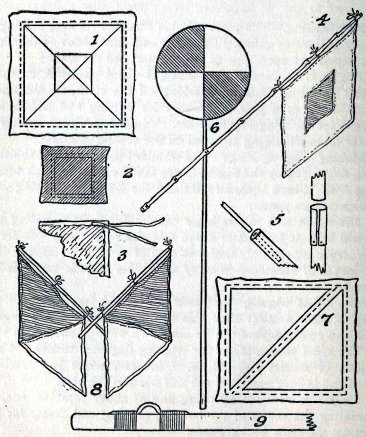 CHART 16
CHART 16
 The
Science Notebook
The
Science Notebook The
Science Notebook
The
Science Notebook



